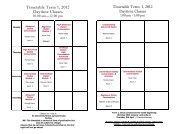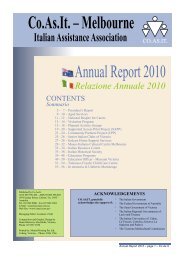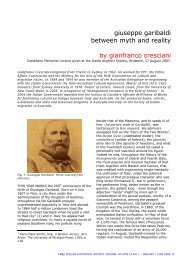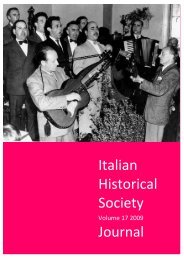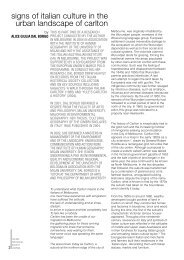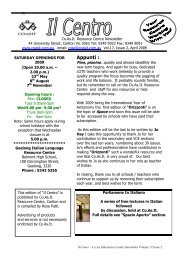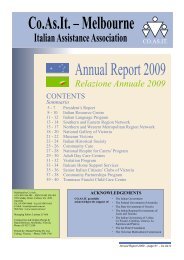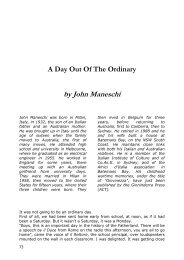January-December 2010, vol. 1
January-December 2010, vol. 1
January-December 2010, vol. 1
- No tags were found...
Create successful ePaper yourself
Turn your PDF publications into a flip-book with our unique Google optimized e-Paper software.
for their beauty, especially Salina, with its twin peaks, MonteFossa di Felce on the eastern side, 962 metres high, and Montedei Porri on the western side, 860 metres high. They werecalled “The Twins” by the ancient Greeks. 7 Whencontemplating this beauty today, one is led to wonder whatcalamity could have caused Antonino and Giuseppa, and somany others, to leave and migrate to a distant, unknown land.However, beauty alone is not sufficient to sustain life.Abandoned terraces on the mountain sides hint at a cause.Fig. 1 Malfa with the north spur of Monte Fossa di Felce. Imagecourtesy of Tony Santospirito.Fig. 2 Rinella with Leni and Monte di Porri above. Image courtesy ofTony Santospirito.The reasons for this mass migration lie in the Italian historicalbackground, and in the Italian political, economic, social andagricultural conditions of the time 8 . These form the basis for thefollowing summary of conditions in Italy in the late nineteenthcentury.The unification of Italy began in 1860. In that year, the south,through the agency of Garibaldi, and parts of the north, wereincorporated into the kingdom of Victor Emmanuel II, King ofPiedmont, of the House of Savoy. The unification wascompleted in 1870 with the conquest of Rome. For severalcenturies before unification, the south was ruled by Spain andthen by a branch of the Bourbon kings of Spain. Under their rule7 Leopoldo Zagami, Lipari ed i suoi cinque millenni di storia (Messina:Tipografia Ditta D’Amico, 1960), pp. 11-12.8 I refer in particular to the works of Amfitheatrof, 1973, Smith, 1997,and Triaca, 1997 cited in the Bibliography.the south degenerated into feudalism, backwardness, andpoverty, while the north developed culturally and economically.In the early part of the nineteenth century, there were frequentrebellions by Sicilians against the Bourbon kings. However,these were put down ruthlessly.The overwhelming majority of southerners were peasantswithout land or education. Those who did own land hadprestige and looked down on those who did not. 9 Despite theirfervent faith they were inclined to superstition. Antoninohimself was illiterate. He had to sign his application fornaturalisation with an “X”. Amphitheatrof, describing thesituation of the southern Italians who migrated to the USA inthe late nineteenth century, said they were “the mostdisadvantaged and humble white people that other Americanshad ever seen.” 10In this situation it was no wonder that unification was seen bysoutherners as a beacon of hope. However, this hope was soonirrevocably dashed. The northern rulers did not carry out thenecessary social reforms. Instead, vast sums were spent onforeign policy, armaments and military ventures in Africa. Taxeson agriculture remained high. Banditry in southern Italy wassuppressed by Piedmontese soldiers. To the southerners itappeared that the Piedmontese government had turned out tobe just another foreign oppressor. It could not command theirloyalty.The economic situation was no better for southerners than thepolitical situation. Unemployment and poverty in the southbecame worse. The staple diet of southerners was not pasta,but mainly bread, olive oil and beans. Exports of wine to Franceremained high until 1888, since Phylloxera, a tiny insect pest,had ruined the French grape harvests. However, in that year atariff war with France cut off that source of income. Phylloxerawas already destroying crops in the Aeolian Islands by 1890. 11 Itreached Sicily by 1892 with devastating effect, just when theFrench started using vines which were resistant to the pest. 12Southerners now realised that other countries offered theironly hope for a better life.The interesting question is why did so many Aeolian Islanders,in particular, choose Australia, a country so far from their own?Some Aeolian islanders came to Melbourne in this period. Theirnumbers were small in absolute terms but so were thenumbers of other Italian immigrants. At the time of Federation,1901, there were barely 5,600 Italians from all provinces in the9 Zita Carew, From capers to quandongs (Salisbury, S. Aust: CountryIdylls, 1997), p. 5.10 Erik Amfitheatrof, p. 137.11 M. Triaca, “Italians in Australia from the Aeolian Islands –Contributions to Literature.” Grad Dip of Librarianship diss., 1977, p. 56.12 New York Times, 8 November 1895, quoting the U.S. consul inPalermo.IHSJ ITALIAN HISTORICAL SOCIETY JOURNAL VOLUME 18 <strong>2010</strong> | 7



